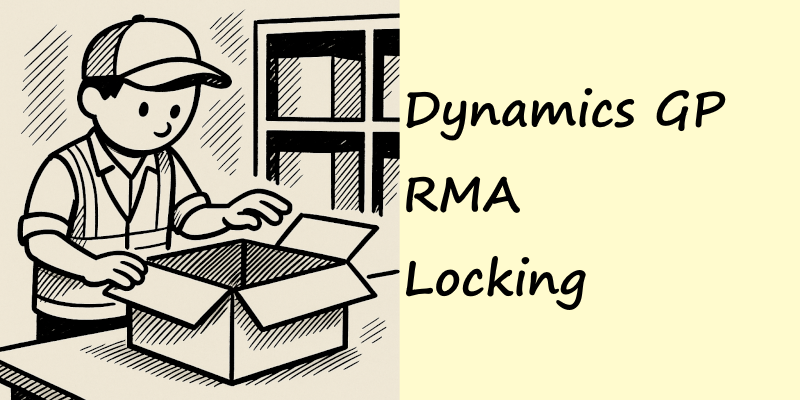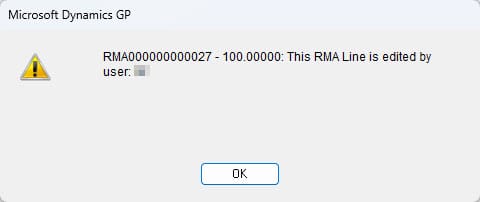"RMA Line is edited by user" locked RMA record in Dynamics GP
Post an RMA receipt in GP’s RMA Receiving window, GP locks the RMA Entry/Edit, even after logout. Only the same user clearing it via RMA Entry can unlock it. This bottlenecks separated warehouse/service workflows.

What We Discovered
When warehouse staff post an RMA receipt in the RMA Receiving window of Dynamics GP, a lock is created on that RMA using the SVC00205 table. This lock persists even if the user logs out or even exits GP.
If another user attempts to process the same RMA using the RMA Entry/Edit window, they receive an error such as:

To release the lock, only the original user must visit the RMA in RMA Entry, click Save, and close the window. That step doesn’t align well with typical SME/SMB workflows where those editing RMAs is differnet to goods in logistics.
Confirmation from Microsoft Support
According to a Microsoft support explanation on the community forum:
“This is working as designed. … A record is inserted into SVC00205 when a user posts a line in RMA Receiving, and remains until that same user opens RMA Entry and saves the line. … [This] is designed to prevent double RMA receiving posting.”
Original post: RMA... This RMA Lines is edited by user: xxx
This design was introduced with GP 2013.
Why This Matters Operationally
-
Separation of Roles
Warehouse teams process receipts while typically, customer service handles the rest of the RMA workflow. Coordinating the RMA. -
Limited Access
Warehouse users often don’t have access to the RMA Entry window at all, indeed shouldn't have. -
Process Bottleneck
Locked RMAs, delay credits and workflow progression, causing support nightmare.
Current Workarounds & Limitations
-
Nightly SQL Cleanup
Schedule a nightly SQL server agent job to clear stale records from SVC00205 (DELETE FROM SVC00205). It works, but carries inherent risk—some locks may still be valid. -
Custom Triggers
Others use SQL triggers to clear locks when the receiving window closes. These require careful handling to avoid unintended consequences.
Recommended Solution: Window Customization
A more robust solution is to customize the RMA Receiving window so that once posting is complete, the record in SVC00205 is cleared upon exiting the window. Benefits include:
- No need for warehouse users to access RMA Entry.
- RMA records unlock immediately.
- Customer service can continue work without delay.
- Eliminates dependence on scheduled jobs or manual scripts.
Summary
- GP’s RMA lock behavior (GP 2013+) is by design, intended to avoid double posting
- Real-world processes—especially in SMEs—often separate warehouse and service roles, causing friction.
- While SQL cleanups are feasible, they carry risk and are not always immediate, depending on implementation.
- My recommendation: customize the RMA Receiving window for a clean process.
